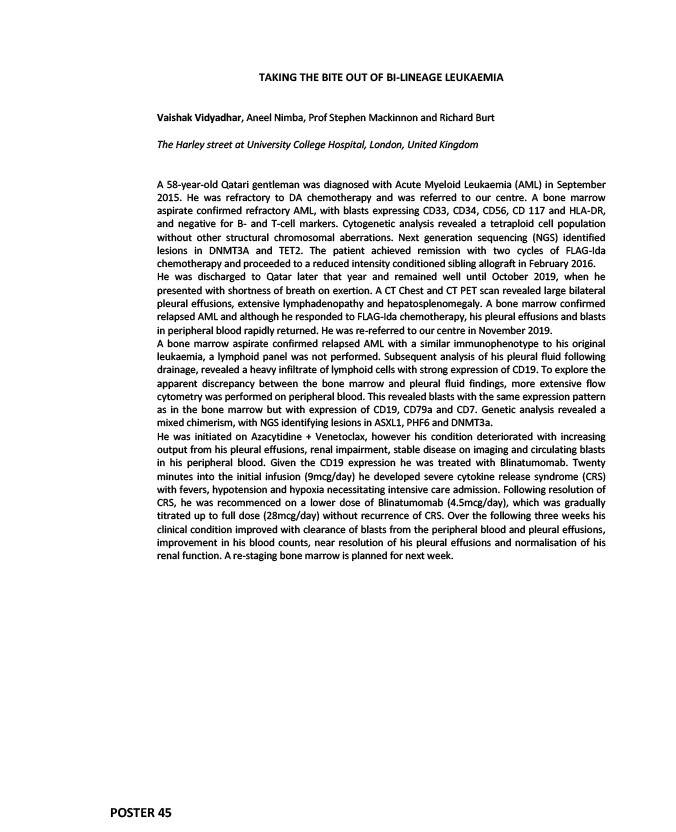
POSTER 45
TAKING THE BITE OUT OF BI-LINEAGE LEUKAEMIA
Vaishak Vidyadhar, Aneel Nimba, Prof Stephen Mackinnon and Richard Burt
The Harley street at University College Hospital, London, United Kingdom
A 58-year-old Qatari gentleman was diagnosed with Acute Myeloid Leukaemia (AML) in September
2015. He was refractory to DA chemotherapy and was referred to our centre. A bone marrow
aspirate confirmed refractory AML, with blasts expressing CD33, CD34, CD56, CD 117 and HLA-DR,
and negative for B- and T-cell markers. Cytogenetic analysis revealed a tetraploid cell population
without other structural chromosomal aberrations. Next generation sequencing (NGS) identified
lesions in DNMT3A and TET2. The patient achieved remission with two cycles of FLAG-Ida
chemotherapy and proceeded to a reduced intensity conditioned sibling allograft in February 2016.
He was discharged to Qatar later that year and remained well until October 2019, when he
presented with shortness of breath on exertion. A CT Chest and CT PET scan revealed large bilateral
pleural effusions, extensive lymphadenopathy and hepatosplenomegaly. A bone marrow confirmed
relapsed AML and although he responded to FLAG-Ida chemotherapy, his pleural effusions and blasts
in peripheral blood rapidly returned. He was re-referred to our centre in November 2019.
A bone marrow aspirate confirmed relapsed AML with a similar immunophenotype to his original
leukaemia, a lymphoid panel was not performed. Subsequent analysis of his pleural fluid following
drainage, revealed a heavy infiltrate of lymphoid cells with strong expression of CD19. To explore the
apparent discrepancy between the bone marrow and pleural fluid findings, more extensive flow
cytometry was performed on peripheral blood. This revealed blasts with the same expression pattern
as in the bone marrow but with expression of CD19, CD79a and CD7. Genetic analysis revealed a
mixed chimerism, with NGS identifying lesions in ASXL1, PHF6 and DNMT3a.
He was initiated on Azacytidine + Venetoclax, however his condition deteriorated with increasing
output from his pleural effusions, renal impairment, stable disease on imaging and circulating blasts
in his peripheral blood. Given the CD19 expression he was treated with Blinatumomab. Twenty
minutes into the initial infusion (9mcg/day) he developed severe cytokine release syndrome (CRS)
with fevers, hypotension and hypoxia necessitating intensive care admission. Following resolution of
CRS, he was recommenced on a lower dose of Blinatumomab (4.5mcg/day), which was gradually
titrated up to full dose (28mcg/day) without recurrence of CRS. Over the following three weeks his
clinical condition improved with clearance of blasts from the peripheral blood and pleural effusions,
improvement in his blood counts, near resolution of his pleural effusions and normalisation of his
renal function. A re-staging bone marrow is planned for next week.